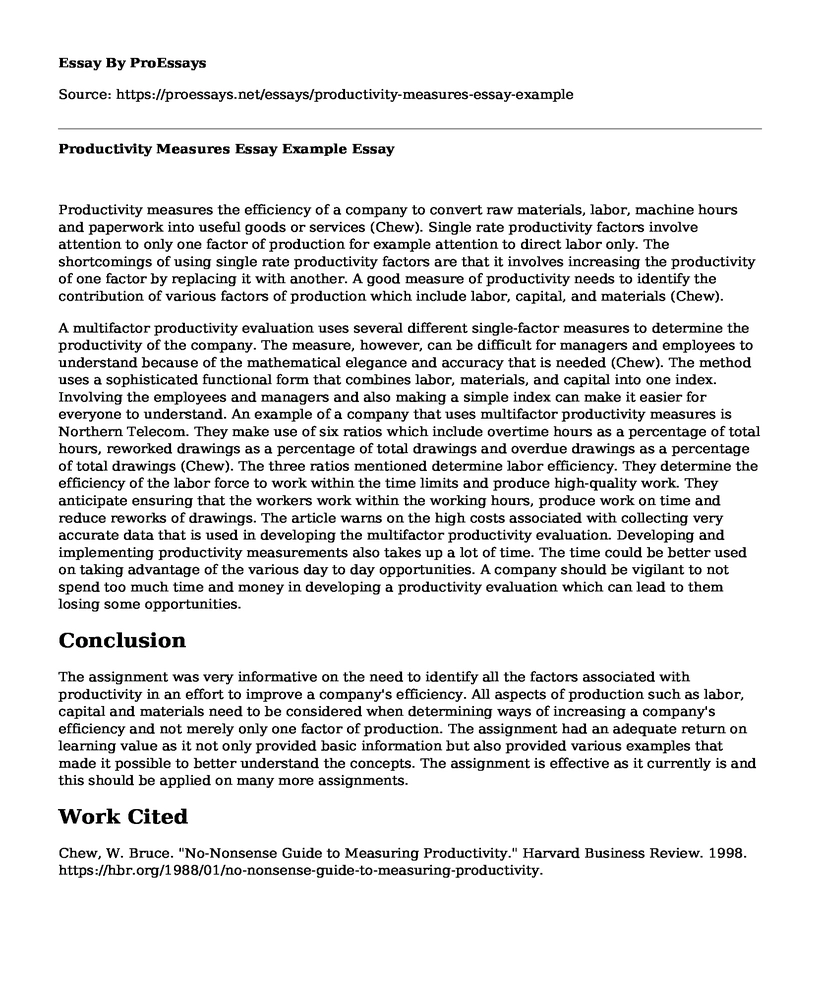Productivity measures the efficiency of a company to convert raw materials, labor, machine hours and paperwork into useful goods or services (Chew). Single rate productivity factors involve attention to only one factor of production for example attention to direct labor only. The shortcomings of using single rate productivity factors are that it involves increasing the productivity of one factor by replacing it with another. A good measure of productivity needs to identify the contribution of various factors of production which include labor, capital, and materials (Chew).
A multifactor productivity evaluation uses several different single-factor measures to determine the productivity of the company. The measure, however, can be difficult for managers and employees to understand because of the mathematical elegance and accuracy that is needed (Chew). The method uses a sophisticated functional form that combines labor, materials, and capital into one index. Involving the employees and managers and also making a simple index can make it easier for everyone to understand. An example of a company that uses multifactor productivity measures is Northern Telecom. They make use of six ratios which include overtime hours as a percentage of total hours, reworked drawings as a percentage of total drawings and overdue drawings as a percentage of total drawings (Chew). The three ratios mentioned determine labor efficiency. They determine the efficiency of the labor force to work within the time limits and produce high-quality work. They anticipate ensuring that the workers work within the working hours, produce work on time and reduce reworks of drawings. The article warns on the high costs associated with collecting very accurate data that is used in developing the multifactor productivity evaluation. Developing and implementing productivity measurements also takes up a lot of time. The time could be better used on taking advantage of the various day to day opportunities. A company should be vigilant to not spend too much time and money in developing a productivity evaluation which can lead to them losing some opportunities.
Conclusion
The assignment was very informative on the need to identify all the factors associated with productivity in an effort to improve a company's efficiency. All aspects of production such as labor, capital and materials need to be considered when determining ways of increasing a company's efficiency and not merely only one factor of production. The assignment had an adequate return on learning value as it not only provided basic information but also provided various examples that made it possible to better understand the concepts. The assignment is effective as it currently is and this should be applied on many more assignments.
Work Cited
Chew, W. Bruce. "No-Nonsense Guide to Measuring Productivity." Harvard Business Review. 1998. https://hbr.org/1988/01/no-nonsense-guide-to-measuring-productivity.
Cite this page
Productivity Measures Essay Example. (2022, Nov 20). Retrieved from https://proessays.net/essays/productivity-measures-essay-example
If you are the original author of this essay and no longer wish to have it published on the ProEssays website, please click below to request its removal:
- Customers in Co-Creation of Products and Services
- Research Paper on Dashboard Benchmark Metrics
- A Review of Wal-Mart's Behaviors, Actions, and Communications
- Review of Dragon's Breath LLC Qualifications Paper Example
- Essay Sample on FIJI Water Strategy
- My Evaluation of Online Shopping Essay Example
- DairyMate Organization Transforming Operations to Cloud: Reaching New Levels With Tech & Bio - Essay Sample







